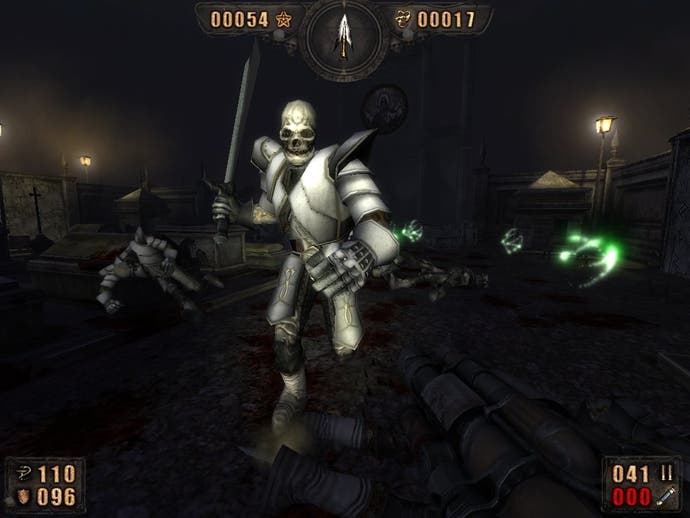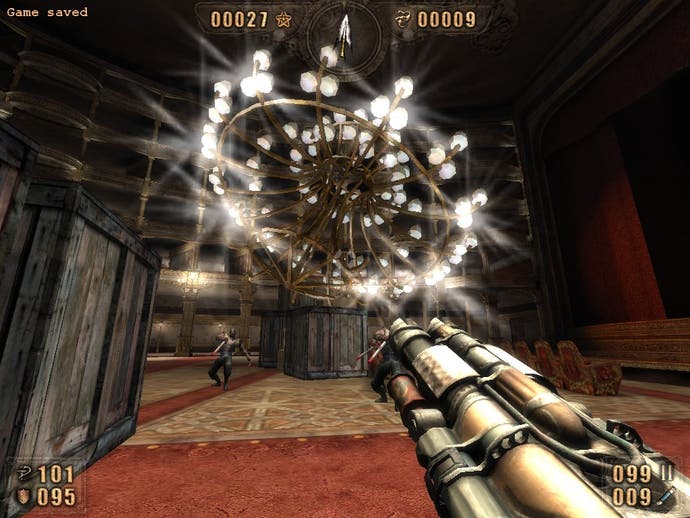Retrospective: Painkiller
Before the Bulletstorm.
A chap called Daniel Garner accidentally drives into a truck on his wife's birthday and they both die. For a game that's heavy on spearing zombies to walls through the face and giggling, it's all a bit melodramatic. Trapped in purgatory, the only way to rejoin his wife in heaven is to become an agent of various angelic and demonic creatures - one of whom has her boobs half out. His mission? To kill wave after wave of the hell creatures marauding towards him, then to move forward a bit and trigger another spawn. It's the sort of stuff that Milton would have come up with if he'd had greater access to Nuts magazine and methylated spirits.
Now developing Bulletstorm with their buddies at Epic, Polish studio People Can Fly created a rough-edged marvel with Painkiller. At the time much of the instant appeal came from the fact that the game appeared at the dawn of in-game physics and ragdolls (nobody had ever nailed a gasmask-wearing WW1 soldier in the leg and seen him dangle from the ceiling of an Underground station before) yet even six years on those simple pleasures remain. The gut-pinning, momentum-harbouring stakegun, as lovingly ripped off by BioShock 2's speargun, is still the most satisfying FPS weapon of modern times.

It's the art style that continues to impress the most though: the bad guys look gorgeous no matter which way they're flying and wherever way their legs are splayed. Cowled Jawa-esque monks armed with axes, whimpering eyeless zombies crawling on an asylum ceiling, witches darting overhead on flaming broomsticks... Painkiller's AI may have worked in a straight line, but the minds that created these monsters certainly didn't. And those enemies got big - huge even. Six years down the line facing one of Painkiller's hundred-feet high bosses is still an awesome experience.
There are few games that let you run between the legs of a goliath hellbeast and shoot him in the unmentionables, while he angrily slams the ground with a hammer the size of a bus and crumbles the physics-laden scenery. The first time you, and various pieces of ancient masonry, are thrown into the air at the moment of hammer impact is just as exhilarating now as it was six years ago.

To house this towering menagerie though, you need vast and echoing levels - and this is again an area in which Painkiller summons a degree of awe. For a start, the slices of hell that People Can Fly designed were often highly imaginative - for every generic graveyard there was a beautiful opera house, for every medieval town there was a Venetian city on water or old-times train station invaded by the war dead.
These levels could often only be described as cavernous: Painkiller's high vaulted ceilings really pull out the feelings of personal-tininess that you get when walking into a real world cathedral or stadium. No shooter apart from the original Doom has ever toyed with scale to such a successful degree; and despite the primarily rush-n-hack enemies there's an awful lot of lines here that can be traced from id to the Warsaw offices of People Can Fly. The setting, the colossal bosses, the wide open spaces, the distant growls and grumbles and the multiple spawns are all very Doom-y, while the pursuit of a pure, fast and simple form of deathmatch certainly feels a lot like Quake.

